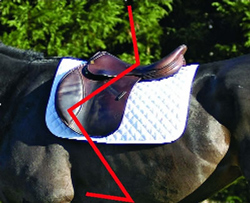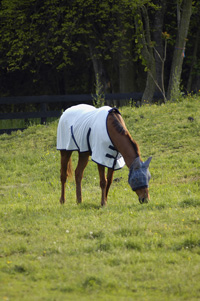Let me ask you a question: Would you try to show jump in a dressage saddle? Of course not, right? What about doing dressage in a steeplechase saddle? Same answer. My point is that the design of your saddle can have a big effect on your riding, so you have to make sure that your saddle is helping you and not getting in your way.

It goes without saying that whatever saddle you are using must fit your horse, but I will say it anyway because it is so important. Your horse’s comfort and well-being come first. If you can feel your horse’s shoulders come up and his back relax in the show-jumping saddle you’ve borrowed, you have to use it even though it feels like it’s burning a hole in your seat bones because your horse is telling you it is comfortable for him. While you are looking for one that fits you as well as your horse, tell yourself you can stand anything for a little while. I mean, just look at your ex-boyfriend or -girlfriend!
Before I tell you how to find out if your jumping saddle fits you, let me make this point: If you are currently using an “all-purpose” saddle for all three phases of eventing, continue using it, but budget for a new saddle. If you are serious about improving your riding and the way your horse goes which, of course, means improving your position–you are soon going to need at least two saddles: one designed for dressage and one for jumping. Why? Because what makes a saddle good for one discipline makes it wrong for another.
The relationship between the design of the flap and the placement of the saddle’s balance point (more on these in a moment) determines the suitability of a saddle for a specific discipline. For example, if you lengthen your stirrups to ride dressage in your all-purpose saddle, you’re probably going to be sitting a little too far behind the motion of your horse because the balance point where your seat bones naturally want to fit is located farther back to allow for jumping. In fact, if it’s not located farther back, it’s going to be a very awkward saddle to jump out of, because a saddle shaped like this causes your lower leg to slip back. (You’ll do fine through Preliminary level with two saddles that fit both your horse and you. When you start riding in the rarified atmosphere of the upper levels, however, you will need three saddles–one for each discipline.)

Now that you know why you need a dedicated jumping saddle, let’s move on to how it fits you. Remember: If your saddle fits you, it will help you, and if it does not fit you, it will get in your way.
To check the fit of your jumping saddle, perform this simple test: Have someone hold your horse while you drop both stirrups and let your legs hang straight down. Move your seat bones all the way from the cantle to the pommel. Now scoot back in the saddle until your seat bones feel comfortable in the lowest part of the saddle. Saddle makers refer to this place as the “swale”; I call it the “balance point.”

Once you are in the balance point, have your coach or a friend push your foot up until she has formed a 90-degree angle behind your knee. You should now feel that the knee roll is in front of your knee. If your knee is over the knee roll or more than two inches behind the knee roll, the saddle does not fit you.
The relationship between the balance point and the shape of the flap is complex, and we need to think about it for a moment. The shape of a dressage saddle’s flap is quite straight due to the deep leg position we need for dressage. When we ride with long stirrups, the saddle’s balance point should be just behind the stirrup bars. As we shorten our stirrups for jumping, the balance point of the saddle must move farther back and the shape of the flap must be shorter and more forward if we are to remain in balance in the saddle.
Another factor that will affect the fit of your saddle is the length of the flap relative to your leg. I have always wanted a supple, thin, sensitive connection between my leg, my saddle and my horse, so I am very aware of the feel that all my saddles give me in my calf area especially my show-jumping and cross-country saddles. As the length of the stirrup shortens, the length of the saddle flap also should shorten, or your saddle will interfere with your lower leg connection. The flap should extend only about 9 inches below the point where the inside of your knee connects with the flap.
Now a word on knee rolls: Although many saddle designs are advertised to give additional “security” because they are padded in various places, more knee roll (or other padding) does not necessarily mean more stability. The only things I want between my knee and my horse’s shoulder are two supple pieces of leather and a soft fleece pad. In fact, if there is a lot of knee roll directly under your knee, it will make your knee turn out, cause your lower leg to pivot backward and interfere with your feel of your horse.

Make sure the knee roll stops at the point of your knee. If the knee roll continues down and around toward your shin, it will cause your lower leg to slip back. Especially when you land over a jump, you want your knee and thigh to fit under a small ledge formed by the knee roll, not to have a large knee roll pressing back on the point of your knee as you land. As for “rear thigh blocks” located behind the rider’s leg, I see them on saddles all the time and I dislike them. They’re especially bad for cross-country because they interfere when you jump up big banks your lower leg can’t remain vertical to the ground because the block interferes.
Finally, a word on saddle size: The seat-size measurement given for a saddle (for example, 17 inches) does not mean much when it comes to trying one out. The width of the tree is a much more important measurement because it tells you how the saddle will fit your horse. Use seat size as a general guideline, but also make sure to perform the saddle-fit exercise I described above.
This article originally appeared in the April 2007 issue of Practical Horseman.










